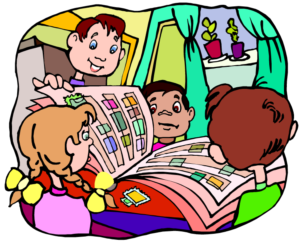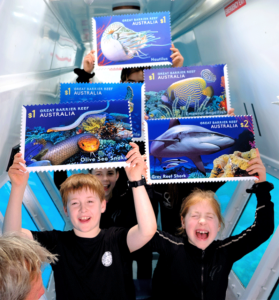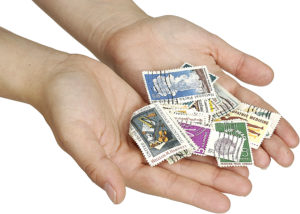By John M. Hotchner
 A recent reader question asked what to do to encourage stamp collecting with a grandchild 450 miles away with not a lot of opportunity for “heads together” collaboration? The grandparent is able to visit a couple of times a year, but what to do in between visits?
A recent reader question asked what to do to encourage stamp collecting with a grandchild 450 miles away with not a lot of opportunity for “heads together” collaboration? The grandparent is able to visit a couple of times a year, but what to do in between visits?
This hits close to home as I have the same situation with grandchildren on the opposite coast. Beyond sending stamps every so often and hoping nature might take its course, I had not thought about how to construct a more effective program. This column will attempt to do just that.
Let’s start with a few assumptions I think are valid:
- The concept of “postage stamps” will not register with most kids until ages 5 or 6. Until then, colored bits of paper can be attractive as playthings, and for art projects. Stickers (which unlike stamps have no intrinsic value) are a good substitute to prepare younger children for stamp collecting.
- Once postage stamps, their use, and their variety are on the child’s radar screen, adults need to understand how they can be seen by kids as an attractive pursuit. I
 think there are at least seven ways that stamps can appeal to kids:
think there are at least seven ways that stamps can appeal to kids:
- Their entertainment value—what can they be used for that’s fun?
- Their value as a way to connect with other kids, and with familiar adults.
- Their value as a reflection of their own life, their family, where they live, etc.
- Their value as property—The concept of something “that belongs to me” develops during the 5-and-up period, and if it has real value, kids at younger and younger ages are “getting” the concept of ownership of something with value.
- Their value as a means of exercising the basic human imperative to organize. This is one of stamp collecting great strengths—organizing by country, by design content, by time period, by sets within country, etc.
- As a means of gaining positive attention and feedback from the adults who matter in their lives.
- To satisfy the natural childhood quest for knowledge toward understanding the world he or she lives in.
So, the essential question is how do we grandparents use these insights to introduce philately in ways that children will feel a positive pull to the hobby as they get older? Let’s take a deeper dive into each of the seven categories.
 Entertainment value: Stamps can be the basis of games, art projects, creative writing, and more. It can also be entertainment to receive presents of stamps in the mail, and to watch for stamps on the mail.
Entertainment value: Stamps can be the basis of games, art projects, creative writing, and more. It can also be entertainment to receive presents of stamps in the mail, and to watch for stamps on the mail.
Connections: Double your pleasure—Double your fun by sharing an interest that is ageless and encourages talking to exchange information that is heavy on positives—unlike so much of adult-child relationships.
Reflecting their lives: Stamps can illustrate where they and relatives live, what the adults in their lives do for a living, their own interests, their pets, what they are learning at school, sports in which they participate, and more.
Property: Children, like adults, learn to assess their own value by what they own. The problem is that most kids don’t own very much beyond their clothes and a few toys. A stamp collection offers not just ownership, but it can be shaped by a child to be a very personal possession.
Organizing: Younger children can organize by color, by design subject, for older stamps, by face value. As they grow and learn to read, organizing by country, and by date of issue can be added.
 Positive Attention/Feedback: Every accomplishment from organizing, to completing a game, to learning the name a foreign country calls itself (e.g. Helvetia = Switzerland) is an opportunity for praise.
Positive Attention/Feedback: Every accomplishment from organizing, to completing a game, to learning the name a foreign country calls itself (e.g. Helvetia = Switzerland) is an opportunity for praise.
Quest for Knowledge: The childhood brain is a sponge for knowledge of all types. There is joy in making the connections that help us to understand our lives in terms of place, emotions, family, our time in history, our artistic sense, our connections to others, and more.
In all these areas, success tends to build on success in ways that are addictive. I have observed over time that stamp collecting is best passed from one person to another not by telling another person that they should be a collector, but by making stamps available, and being a mentor (as distinct from an instructor — kids especially have enough rules to follow). The role of a mentor is to answer questions, provide alternatives, organize and participate in activities, teach good practice, ease obtaining of needed implements, and occasionally warn about the sand traps (e.g., not using sticky tape to put stamps in an album).
So, with this as background, what can a non-resident grandparent do to encourage stamp collecting? What follows is not in any special order; just as things occur to me: So, with this as background, what can a non-resident grandparent do to encourage stamp collecting? What follows is not in any special order; just as things occur to me:
- Provide stamps by mail — a few at a time — that are likely to interest the child, and point out special ones that relate to the child’s family and interests, current events, or that have special historical significance. Use attractive commemoratives on your mail.
- Encourage them to talk on the phone, by Skype, and eventually by email, about the ones they especially like.
- Ask them to pick a stamp that they like from their collection, help them identify it, and then encourage them to use its design as a starting point for a story that can be true or not. You can in response add your perspective to the story, or a new chapter. With encouragement and praise, this can become a regular activity.
- When you visit, bring stamps from your own collection to show what it is that you find fascinating.
- Encourage the child to reach out to other relatives to save stamps for them, and to parents and adult friends to bring home stamps from business mail.
- Send for first day covers for new stamps that will arrive in the mail addressed to the child.
- Provide collecting implements (stock cards, albums, glassine envelopes, stamp tongs, hinges, etc.) as needed. Some of these can be brought when you visit so that you can explain in person how to use them.
- Help them with organizing. Help them fill in sets or lists. For example, the presidential set of 1938, or at least one stamp showing each president since George Washington; or a series of precancels that show origin in all 50 states.
- When you visit, show them how to make their own pages for their collection. This can be a page for one stamp or a set; or pages that resemble an album page.
- Take note of the flowers they have in their garden, the animals that can be found in their area, the foods that they like; and when you get home, send stamps that show these things.
 As the child is able to appreciate them, give stamps with value for birthdays and other special occasions. These can be older issues (e.g. 1976 Bicentennial souvenir sheets), or current stamps from the USPS in presentation books or packs. For example, the USPS yearbook makes a colorful and informative Christmas present.
As the child is able to appreciate them, give stamps with value for birthdays and other special occasions. These can be older issues (e.g. 1976 Bicentennial souvenir sheets), or current stamps from the USPS in presentation books or packs. For example, the USPS yearbook makes a colorful and informative Christmas present.- Encourage them to have as one of their collections a group of stamps about their own life: stamps that commemorate their state, show the things they play, eat, their heritage, the stamps issued in the year they were born, places they have visited, etc.
- Encourage their parents to support the collecting activities, and to be a resource themselves even if they don’t collect. They can, for example, teach their kids how to use Google to learn about the people and events they see on stamps.
- If there is more than one grandchild, send different stamps for each, and teach them about how they can trade stamps.
- Plan some stamp collecting activities when they come to visit you. Visit places of historical interest that are shown on stamps, and give them the stamp. Show them how and what you collect.
- Make flash cards to help them learn the foreign names on stamps so they can learn to identify where foreign stamps come from (No name, but a picture of Queen Elizabeth, Noreg, CCCP, Republique Francaise, etc.) Help them find the different countries on a map.
- Encourage them to design stamps that they would like to see and send them to you. A particularly good job might be framed and given to them when you or they visit.
- When you visit or they visit, and the time is right according to their level of interest, take them to a local stamp show, which likely will have a kids corner with free stamps and stamp collecting implements.
- In the same vein, take the child to a local stamp club meeting; some of which have active juniors programs. It may be that someone local will be willing to mentor your grandchild. This is not a complete list, nor does a grandparent have to do all of these things to hook a child’s interest. But it provides a starting point.
Readers are invited to add to the list, or to tell us about your experiences in trying to interest young family members in stamp collecting.
Should you wish to comment on this column, or have questions or ideas you would like to have explored in a future column, please write to John Hotchner, VSC Contribu-tor, P.O. Box 1125, Falls Church, VA 22041-0125, or email, putting “VSC” in the subject line.
Or comment right here.




Pingback: Weekly Phila-Bytes #2019-06 (Valentine’s Edition) – PHILATELIC PURSUITS
Over 36 years of stamps collection in Granby.qc.ca Many collectors beginners and older.Granby Club Reunion two days by month. And we visit Montreal and Boucherville. My favorite is Arpin Philately.qc.Ca
Like to buy book and stamps for my granddaughter age 9 were can I get this item